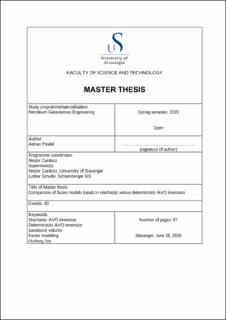| dc.contributor.advisor | Cardozo, Nestor | |
| dc.contributor.advisor | Schulte, Lothar | |
| dc.contributor.author | Pindel, Adrian | |
| dc.date.accessioned | 2020-09-29T13:34:34Z | |
| dc.date.available | 2020-09-29T13:34:34Z | |
| dc.date.issued | 2020 | |
| dc.identifier.uri | https://hdl.handle.net/11250/2680355 | |
| dc.description | Master's thesis in Petroleum Geosciences Engineering | en_US |
| dc.description.abstract | This thesis compares facies models based on deterministic AVO inversion – which is a standard approach in the industry, and stochastic AVO inversion – which is a newer, less popular approach, but according to literature, better for volumetric calculations. The thesis aims to understand the value of stochastic AVO inversion for facies modeling and showcase its superiority over deterministic AVO inversion. These two methods can lead to substantial differences in the estimated Gross Rock Volume of sandstone in a reservoir, which is critical for calculating hydrocarbon reserves.
The study is applied to a dataset provided by Equinor ASA, covering the J-structure of the Oseberg Sør field in the northern North Sea. The reservoir is the Middle Jurassic Brent Group at an approximate depth of 2200-2800 m and consisting of sandstone, shale, and limestone. These are the main lithofacies modeled in the thesis.
The deterministic AVO inversion allows to retrieve elastic properties such as P-impedance and Vp/Vs ratio from the seismic angle stacks. The vertical resolution of the deterministic AVO inversion is limited by the seismic bandwidth, therefore its result is smooth. The stochastic AVO inversion, on the other hand, uses the variogram model to simulate the thin layers below seismic resolution and allows catching the uncertainty of the inverse problem by generating multiple equiprobable realizations of the elastic parameters.
The Bayesian classification algorithm is applied to the well log data to obtain the litho-classification model, which is used to derive sandstone, shale, and carbonate probabilities from the deterministic AVO inversion. Then, facies probabilities are used to guide the sequential indicator simulation (SIS) to get many equiprobable facies models. The deterministic AVO inversion and the well logs are used to obtain the variogram model needed for the stochastic AVO inversion. The litho-classification model is directly applied to multiple realizations of the stochastic AVO inversion to obtain facies models.
The workflow based on the stochastic AVO inversion results in less sandstone in the reservoir Brent-Drake zone than the workflow based on the deterministic AVO inversion. However, the stochastic AVO inversion workflow with a smaller lateral variogram range shifts the sandstone volume towards the results of the deterministic AVO inversion. A lower lateral variogram range introduces a larger variability in the sandstone probability which delivers a similar effect to SIS. Consequently, the lateral variogram range is of critical importance for facies modeling using stochastic AVO inversion, though it has a small impact on the P50 volume obtained from the
deterministic AVO inversion. A decrease of the variogram range decreases the spread of the volume distribution for both types of facies modeling.
Since both workflows can be parametrized to deliver similar results by changing a highly uncertain lateral variogram range, the value of the stochastic AVO inversion for facies modeling is not yet fully understood and requires further research. | en_US |
| dc.language.iso | eng | en_US |
| dc.publisher | University of Stavanger, Norway | en_US |
| dc.relation.ispartofseries | Masteroppgave/UIS-TN-IER/2020; | |
| dc.rights | Navngivelse 4.0 Internasjonal | * |
| dc.rights.uri | http://creativecommons.org/licenses/by/4.0/deed.no | * |
| dc.subject | petroleumsgeologi | en_US |
| dc.subject | Oseberg Sør | en_US |
| dc.subject | deterministic AVO inversion | en_US |
| dc.subject | sandstone volume | en_US |
| dc.subject | facies modeling | en_US |
| dc.subject | stochastic AVO inversion | en_US |
| dc.title | Comparison of facies models based on stochastic versus deterministic AVO inversion | en_US |
| dc.type | Master thesis | en_US |
| dc.subject.nsi | VDP::Teknologi: 500::Berg‑ og petroleumsfag: 510::Geoteknikk: 513 | en_US |
| dc.subject.nsi | VDP::Matematikk og Naturvitenskap: 400::Geofag: 450::Petroleumsgeologi og -geofysikk: 464 | en_US |

